The Apple iPad Air 2 Review
by Joshua Ho on November 7, 2014 9:30 AM EST- Posted in
- Tablets
- Apple
- Mobile
- iOS
- ipad Air 2
Display
While the display is important on a smartphone, by virtue of its sheer size tablets seem to have a more critical need for a good display. With a tablet there’s a great deal more potential for usage models such as drawing/sketching and photo/video editing. In addition, reading books or watching videos is far more common on a tablet, which means that poor resolution, response time, and/or contrast can be quite visible and painful to live with. In order to test this, we use our standard suite of tools, which include SpectraCal’s CalMAN 5 and X-Rite’s i1Pro2 spectrophotometer to make sure that our color readings are as accurate as possible. Colorimeters in practice have varying levels of color accuracy due to their design, and as a result these are only used to verify contrast and gamma curves. As previously mentioned, we test against sRGB gamut as it’s the de facto standard for displays and web content. It’s definitely not a perfect standard by any means, but until a wider gamut becomes standard it’s the one to test against.
Before we get into the objective tests though, there’s a lot of talk about that isn’t easily measured. On the simpler side, the display resolution where I can see a noticeable difference when compared to the iPhone 6 Plus and similarly high resolution devices. The 2048x1536 resolution is nothing to be ashamed of, but when stretched to a 9.7 inch display this means that it’s relatively easy to notice pixelated areas on various curves. At a normal viewing distance though it’s not an obvious issue and I didn’t have any issues with eye strain. There could be some value to going to higher resolutions for the iPad Air 3, but barring some major breakthrough in TFTs or backlight technology such a move would incur a significant cost in power due to losses in backlight efficiency as the LEDs approach maximum power draw.
Speaking of LEDs at maximum power draw, outdoor visibility is often a critical use case. While we focus on maximum brightness, in truth this is really just one part of the equation as high reflectance can effectively erase all of the gains that one can have from higher brightness. Unfortunately, I don’t have the proper equipment to objectively test this, although the test will be ready for next year. In practice, I can definitely see a difference in mirror/specular reflections on the tablet when comparing the Galaxy Note 4, although it’s harder to tell when comparing against the iPhone 6. I can definitely see a difference in what is reflected though, as there’s a noticeable purple hue to white reflections in certain angles which could be a magnesium fluoride coating similar to what one might find on glasses or camera lenses. There’s no obvious flaring issues though, and in practice I don’t see any real degradation of clarity. The improvement from the iPad Air is dramatic, especially as the addition of lamination makes the display noticeably closer to the glass and reduces the reflections that result from the air gap. This change also helps with the viewing angles on the iPad Air 2, which were already quite good with the iPad Air due to the chevron-shaped subpixels. As I said with the iPhone 6 review, this helps to ensure that there's much less color shifting when changing viewing angle, although there is a noticeable shift towards purple in some viewing angles which is mostly noticed on pure black but hard to see in any other case.
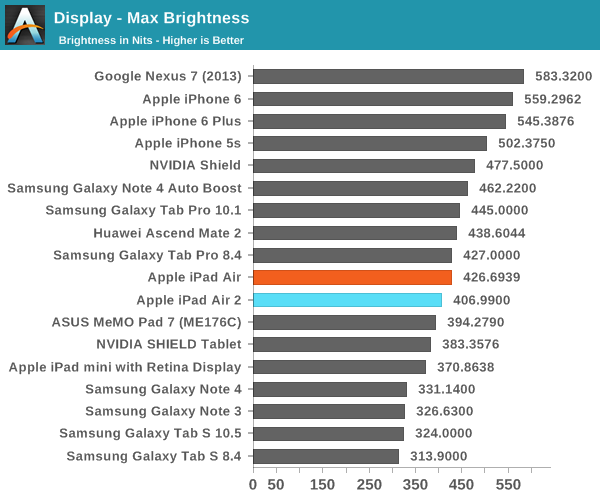

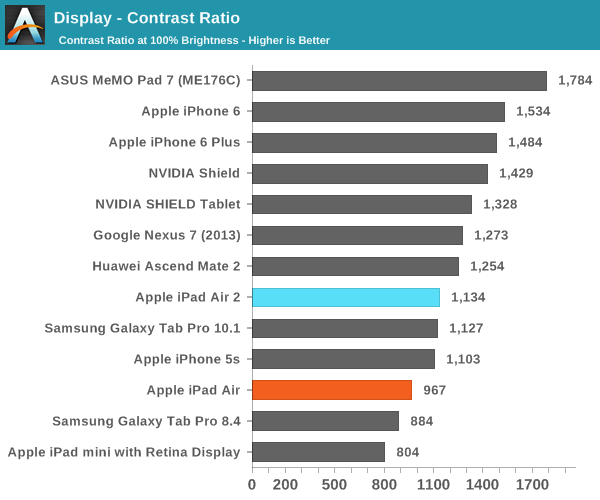
On the actual display characteristics though, we don’t see too much of a difference. Brightness and contrast are quite close to the original iPad Air, which suggests that we’re looking at the same exact display, although production variances may have an effect on things.
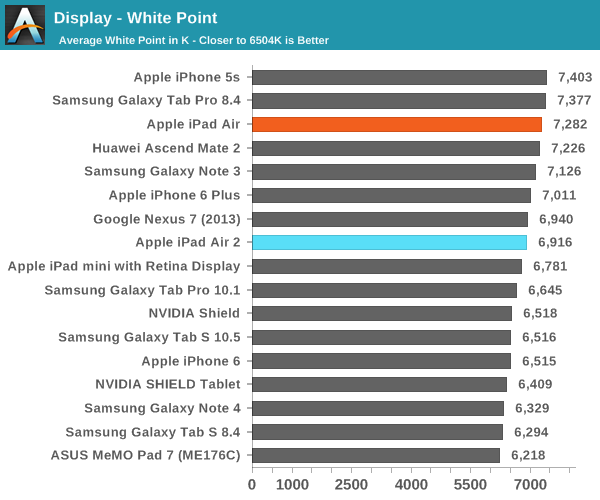
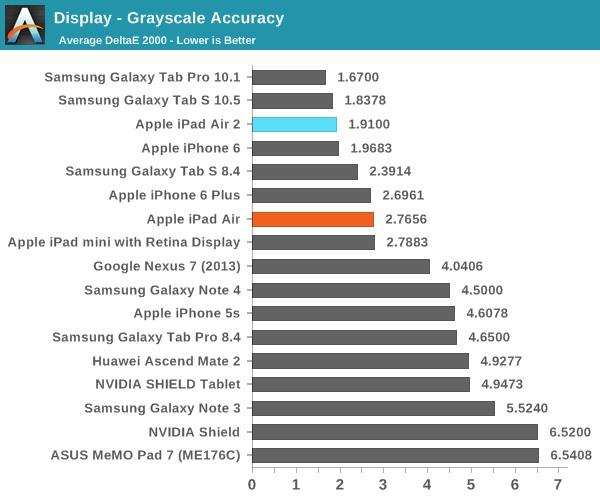
In grayscale, we see some level of improvement to the calibration, although it’s hard to tell whether this is the product of production variance or some level of improvement. In practice grayscale tones are definitely well-rendered, and the blue tint isn’t really significant here. There’s really nothing else to be said, as the visible difference from a reference monitor would be difficult, if not impossible to spot.

For the saturation sweep, which is the next aspect under test we see a similar pattern. While there’s some oversaturation on the blues, there aren’t any other significant issues. The display on the iPad Air 2 is probably similar, if not the same type as the one we’ve seen in the iPad Air as both have the same gamut.
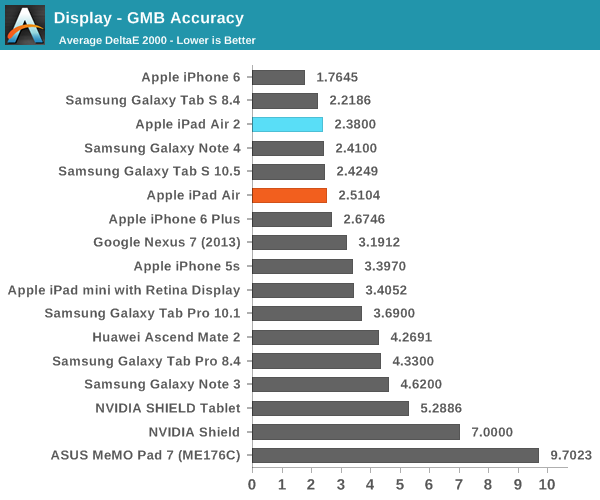
On the GMB ColorChecker, we can generally pick out any issues with display calibration that the saturation sweep won’t show as this test emphasizes hue comparisons along with some grayscale testing. In practice, the iPad Air 2 doesn’t have any issues here as evidenced by the low average error. While there’s noticeable blue shift on some of the hues this shouldn’t be a major problem.
Overall, the quality of the display calibration in the iPad Air 2 is pretty much as good as it gets. While I can name some problems, they’re all minor at best and effectively nit-picking. The fact that I can say this about a tablet display is definitely good news for the state of the industry, as things haven’t quite devolved into a race to the bottom with corners cut in every possible area.
There are some issues with the display overall in terms of peak luminance, but these are likely to be due to the larger display size. These differences when compared to smaller smartphone displays are likely to be due to issues with scaling of the thin film transistor technologies common in smartphone-size displays to tablet-size displays as LTPS backplanes become increasingly expensive to make due to the higher variability involved in the process when compared to IGZO and amorphous silicon processes. Unfortunately, an IGZO backplane seems to gate performance in some key areas as we don’t quite see the levels of brightness and contrast that we do on the iPhone 6 despite lower pixel density.





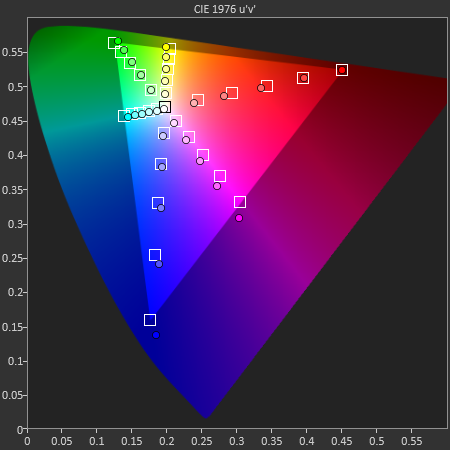
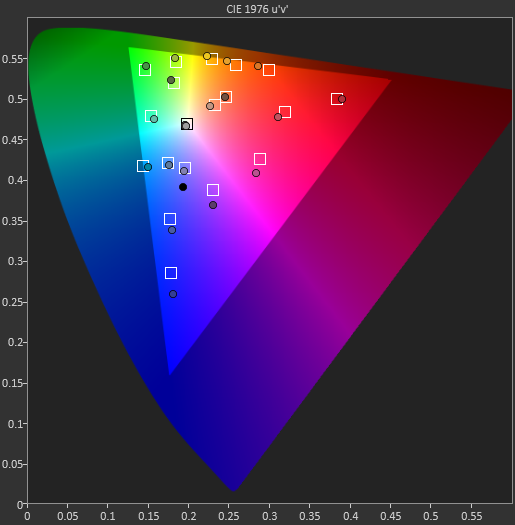








226 Comments
View All Comments
wewewe - Friday, November 7, 2014 - link
Just received mine. Previous was an Ipad 4th gens. One word ! Wow !! This is really magical. Its thin piece of glass with a processing power of a computer. I doubt there is a better tablet experience than this.Hyper72 - Friday, November 7, 2014 - link
I replaced an iPad 2 (512MB RAM) with Air 2, imagine my wow experience...Yes I also enjoy the thinness more than I thought I would. Only using it ~ two hours a day means it has more than plenty juice in any case.
Klug4Pres - Friday, November 7, 2014 - link
" While tablet applications that haven’t been properly scaled on the iPhone line are likely to look horrible due to the scaling factor used. While the same can and does happen with Android apps, it isn’t nearly as obvious because most of the scaling done is far more seamless and simply leaves a great deal of white space in the application that can’t necessarily be used."Please tidy that up by using actual sentences, because it is difficult to understand what you are saying here.
"As a result of all this work, it seems pretty obvious that the iPad Air 2 continues to deliver some of the best tablet software on the market. For the most part, every application available seems to effectively deliver a tablet-specific experience that helps to set the iPad lineup apart from other tablets. Unfortunately, it seems that due to a lack of competition there isn’t much in the way of attempts to dramatically improve the software experience, and as a result it’s a bit difficult for me to justify carrying a tablet around all the time as its size is relatively massive compared to even a 6 inch phablet"
You are saying the iPad Air 2 has some of the best tablet software, but tablets in general are not worth carrying around because they are too big relative to phablets. You attribute this to a lack of competition for the iPad, which means Apple has failed to make dramatic improvements to tablet software, improvements that would be necessary to make it worthwhile to carry tablets. OK. What about just having one for use at home? I think you are trying to say too many unrelated things in this paragraph.
"Overall, the iPad Air 2 is likely to be one of the only tablets worth buying on the market today."
I think this is rather too sweeping a statement for a review focused on one tablet, not very helpful when you omit to mention the other tablets worth buying, and anyway the statement isn't well supported in the article itself.
name99 - Friday, November 7, 2014 - link
"The glass is flat, which makes it seem noticeably different from the iPhone 6 line in that regard as it meets the chamfered edge of the back cover rather than making a seamless curve."iPad manufacturing has always lagged iPhone, I imagine because the volumes are lower.
I wouldn't read any "statement of direction" into this.
For example my iPad Retina came out at the same time as the iPhone 4/4S. The 4/4S was incredibly slick for its time, while the iPad Retina used a sort of lacquer or something to form the bezel around the screen, and there was noticeable unevenness in this lacquer. (Uneven meaning not visible, but you could feel it if you ran your fingers over the bezel.)
Of course the iPhone 5 ramped up slickness of manufacturing to a new level with the really tight tolerances, the feel of a single block of material; the 6 retained that while now converting straight edges to curves. I'd say the iPad Air 2, in terms of manufacturing slickness lives halfway between the 4/4S and the 5/5S. It doesn't QUITE reach that feeling of a single uninterrupted block of material, probably because it's striving for curves --- they might have been able to make it if they'd gone for a look exactly like the 5/5S.
The larger pattern, I think, is that the manufacturing/fit-and-finish is improving for iPads every year; they just suffer in comparison with the absolute perfection of the phone manufacturing.
sporkfan - Friday, November 7, 2014 - link
In agreement with you here. I'm really not a fan of how the TouchID is integrated into the iPad Air 2. I'm not sure if it's just lower tolerances than the iPhone 5s, or perhaps my unit is weird. But if my fingernails are long enough that they contact the ring at all (not that long, I swear!), they catch on the sharp outer edge. It feels icky. On the iPhone 5s this is totally not an issue.feeblegoat - Friday, November 7, 2014 - link
Hey, Josh, the data doesn't really match your conclusions about efficiency too much. I can see that performance degraded slightly more on the shield tablet, but only at the very end, before the last ten minutes. Up until then, performance stays at a steady 57fps (http://www.anandtech.com/show/8329/revisiting-shie... However, considering that this is an onscreen test, I'll assume the 5-7 fps advantage compensates for the lighter workload given by the lower resolution screen. So, assuming the workload is even, then we must consider the battery size difference. Ignoring the screen power usage for now, the Shield Tablet has a 19.75 Wh battery, the Air 2 a 27.62 Wh battery. Ratio the battery numbers with the battery life difference, and we end up looking at a 23% efficiency win for the Air 2, maybe up to 25-28% because of the larger screen. That's a little less than I would actually expect (but pretty close to expectations) considering the A8X is 20nm and the K1 28nm. So if anything, praise the efficiency of 20nm; because considering the gap in architecture, the efficiency is maybe worse than the K1's GPU.Sidenote: (Of course, that's a somewhat invalid argument, because the A8X has 20nm, K1 doesn't, and we can't just say that the K1 is more efficient - it's not. But still, the difference is due to 20nm. Kudos to Imagination, though, for making a GPU that has similar hypothetical efficiency to the juggernaut Nvidia. Can't wait for Maxwell SoC's though. One SMX on a phone?)
techconc - Friday, November 7, 2014 - link
"Ignoring the screen power usage for now"Huh? Once you do that, the rest of your question is meaningless. The screen is the largest power consuming component by a large margin. What's more, you're comparing a device with a 5" screen to a device with a 10" screen and attempting to guess at the efficiency of the chip components based the the respective battery sizes for these devices. That's an exercise in futility as you're not able to draw any meaningful conclusions based on the data you have.
lucam - Friday, November 7, 2014 - link
He doesn't get..so be it..dwade123 - Friday, November 7, 2014 - link
Lol Android devices are nowhere close to the iphone 6 let alone Air 2 in raw power and app library.Morawka - Friday, November 7, 2014 - link
Thanks for the review! finally ! haha